Step-by-Step Guide to Applying for the Digital Europe Programme
Date of information update : 18.08.2025, 10:56
This guide provides general recommendations and common criteria for completing an application for calls under the Digital Europe Programme. Keep in mind that specific requirements, structure, and evaluation criteria may vary depending on the type of call, project topic, and the detailed instructions provided by the European Commission in the official call documentation.
The Digital Europe Programme is a European Union initiative aimed at supporting the deployment of advanced digital technologies across business, the public sector, and society. Unlike research-focused programmes such as Horizon Europe, this programme focuses on scaling ready-to-use solutions, developing digital infrastructure and skills, promoting artificial intelligence, cybersecurity, supercomputing, and data usage.
For Ukrainian entrepreneurs, participating in the Programme is a unique opportunity to:
Receive grant funding for digital products and solutions
Enter EU markets through international partnerships
Become part of European digital initiatives
Contribute to the development of standards and infrastructure that will shape the future of Europe’s digital economy
Since 2022, Ukraine has held the status of an associated country under the Programme. This means Ukrainian companies, organisations, municipalities, universities, and NGOs can fully participate in the calls, on equal footing with applicants from EU member states (except under the cybersecurity strand).
What is a grant application, and what does it include?
To apply for funding under the Programme, you must submit a complete application via the Funding & Tenders Portal (FToP). The application is submitted online and consists of three main parts:
PART A – Administrative Section
Filled out directly on the portal. It includes basic project information, budget, consortium partners, and legal details of participating organisations.
PART B – Technical Section
Prepared as a PDF and uploaded to the portal. This is the core document, where you describe your project idea, objectives, methodology, expected impact, implementation plan, management, and risks.
Annexes
Some calls may require supporting documents, such as letters of support, expert CVs, an ethics self-assessment, a data management plan, etc.
This guide was developed to help Ukrainian entrepreneurs confidently navigate the application process, explain each section in simple language, and provide tips on how to strengthen your proposal and increase its competitiveness.
Step 1: Familiarise Yourself with the Programme and Call Requirements
Before you begin, review the objectives of the Programme and the specific call:
Programme areas: High-performance computing, artificial intelligence, data and cloud technologies, digital skills, and the deployment of digital technologies in the economy and society.
Call details: Review the Work Programme and call documents on the Funding & Tenders Portal (F&T Portal) to ensure your project aligns with the goals.
Consortium requirements: Most calls require a consortium of 3–5 partners from the EU or associated countries (e.g., Ukraine). One partner, usually from an EU country, acts as the coordinator.
Next:
- Visit the F&T Portal, use filters to select the Digital Europe Programme, and find the relevant call.
- In the call description, locate and download the call document, Work Programme, and application templates (Parts A and B).
- Check the deadline, budget, and evaluation criteria (relevance, impact, implementation)
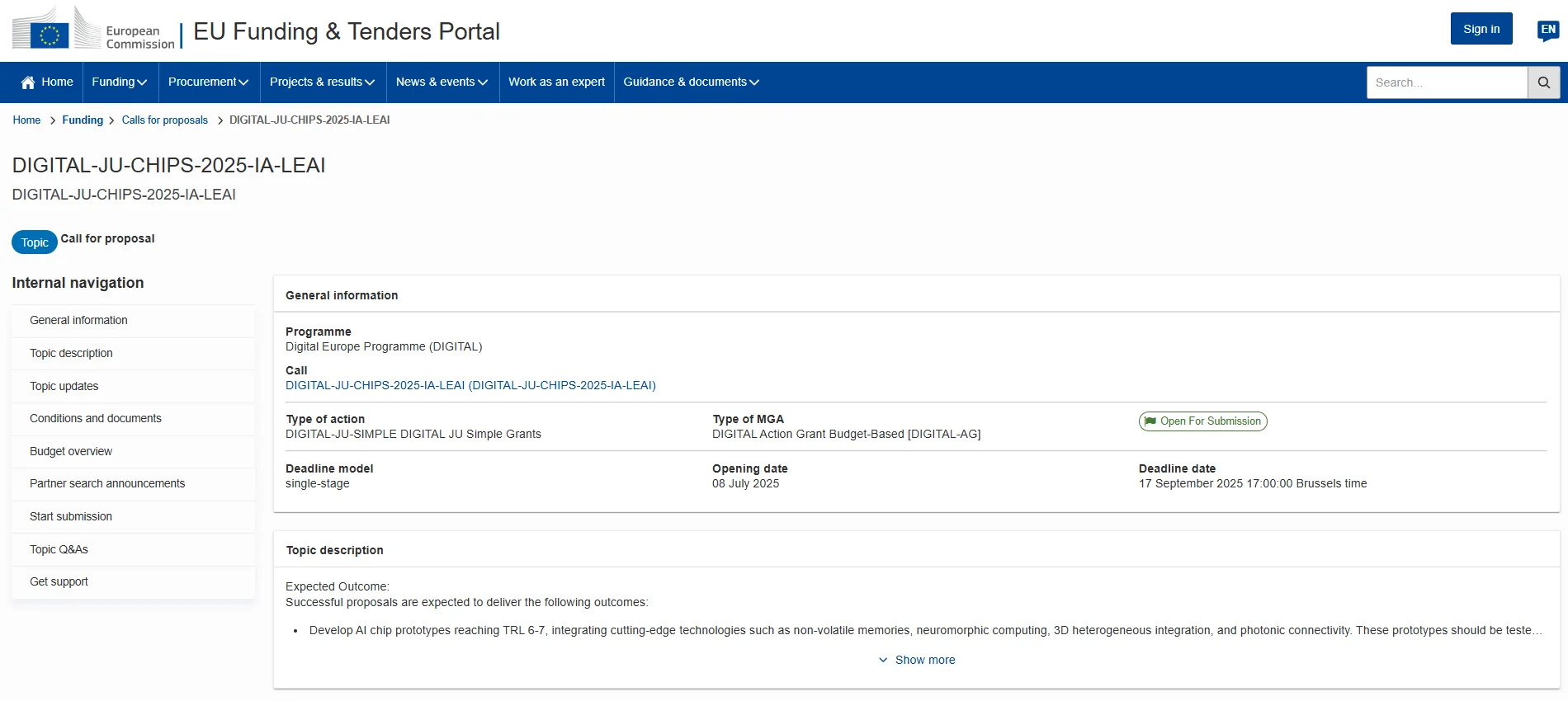
Step 2: Register Your Organisation
To submit an application, all consortium partners must be registered on the F&T Portal:
- Create an EU Login: Sign up via the provided link to access the portal.
- Obtain a PIC code: Register your organisation to get a Participant Identification Code (PIC) required for Part A of the application.
- Provide legal and financial details (e.g. registration extract, VAT number).
- Upload supporting documents (e.g. extract from the Unified State Register).
- Check your partners: All consortium partners must have valid PIC codes and up-to-date documentation.
Tip: Allocate 1–2 weeks for registration, as validation may take time. If you encounter issues or have questions, contact the F&T Portal Support Service.;
Step 3: Form a Consortium
Most calls under the Digital Europe Programme require the establishment of a consortium made up of partners from EU Member States or associated countries. The coordinator submits the application on behalf of the consortium. A consortium is a formal alliance of several organisations from different countries that jointly develop, submit, and implement a project within an EU programme.
- Finding partners:
- Use the Enterprise Europe Network (EEN) to search for potential collaborators.
- Also use the DEP4ALL matchmaking platform to find partners.
- Attend Info Days or relevant webinars.
- Contact Ukraine’s National Contact Point — the State Institution “Entrepreneurship and Export Promotion Office” (ncp@eepo.gov.ua).
- Define roles: Clearly assign responsibilities (e.g. coordinator, work package leader) and prepare a Consortium Agreement.
- Documentation: Include partner details in Part A of the application and describe their contribution in Part B.
Tip: Make sure the consortium includes a diverse mix of competencies (e.g. a university for training, a tech company for infrastructure).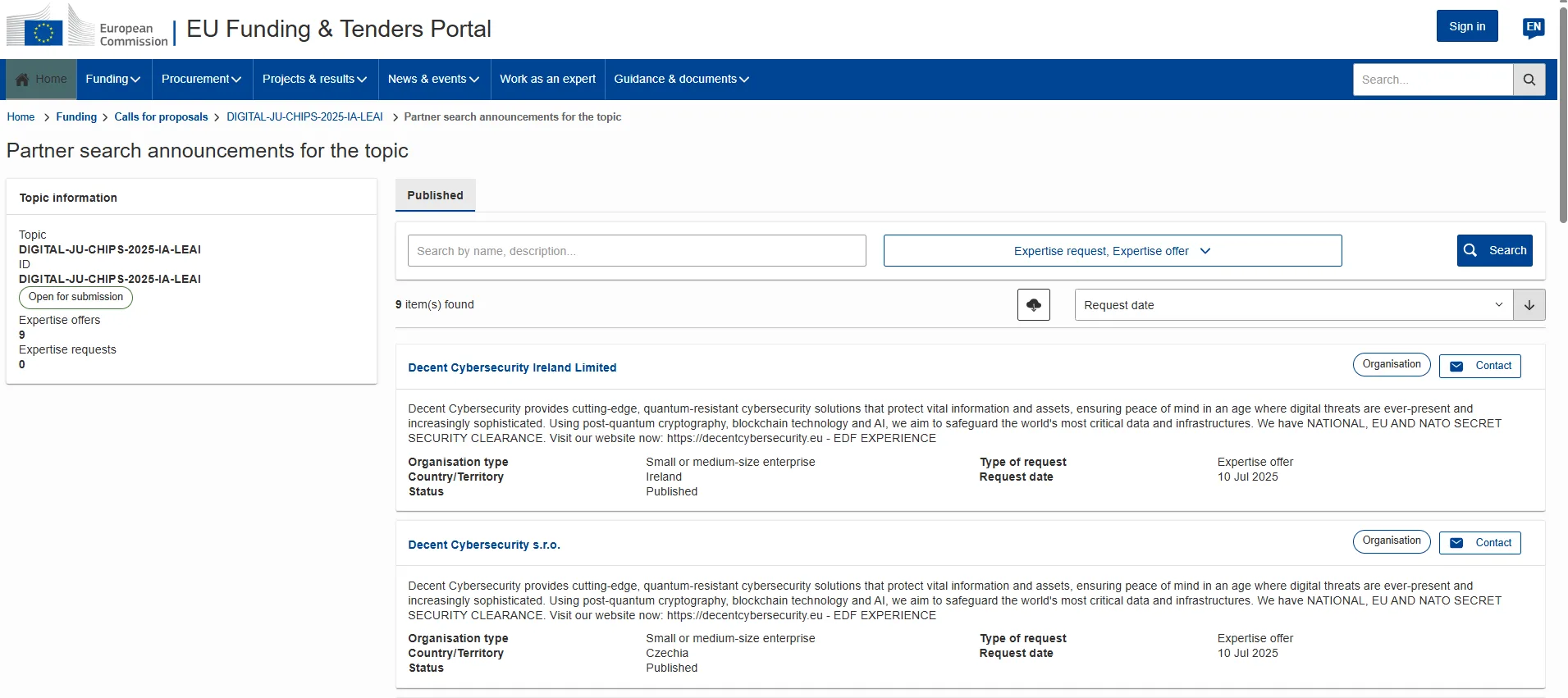
Step 4: Complete Part A (Administrative Forms)
PART A is the administrative section of your application, which you fill out online via the Funding & Tenders Portal. It serves as the “public face” of your project for the European Commission: here, you provide all the key formal information about the project, participating organisations, budget, and contact persons. This section is essential not only for the initial evaluation but also for any further legal and financial interaction with the EU if funding is granted.
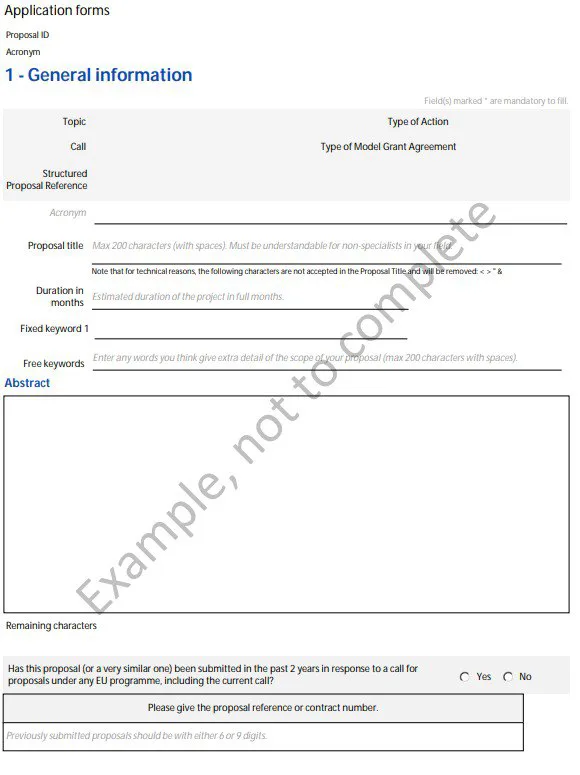
4.1. Project Title
This is the first thing the evaluators will see. The title should be short, informative, and clearly reflect the concept of your initiative. Avoid vague or generic formulations — instead, focus on the outcome or target group.
Recommendations:
Maximum length: 200 characters
Avoid template-like phrases such as “Enhancing Innovation in Europe”
Use keywords that communicate a solution or specific value
Example:
Digital Twin Platform for Predictive Maintenance in Manufacturing SMEs
4.2. Acronym
The acronym is a short identifier of your project that will be used throughout the application process, communication, and reporting stages. You should define it at the beginning and use it consistently.
Recommendations:
- Maximum 20 characters
- Must be unique and not duplicate existing project names (check on CORDIS)
- Often a compound word or abbreviation
- Examples: DIGITRAIN, AGROAI, CLOUDSEC
4.3. Duration
This refers to the total duration of your project in months. It must be realistic — neither too short for an ambitious initiative, nor excessively long to avoid questions about resource efficiency.
Recommendations:
Common options: 18, 24, or 36 months
Align the timeline with your implementation logic: development – testing – scaling
In Part B, you will need to justify project activities for each month
4.4. Priorities / Keywords
These terms help evaluators quickly grasp the focus of your project. They are also used for internal reporting, statistics, and proper assignment to thematic evaluation panels.
Recommendations:
Choose 3–5 keywords that truly reflect your project’s concept
Align with the official priorities of the Digital Europe Programme
Examples of keywords:
cybersecurity, artificial intelligence, green tech, e-health, e-government, data spaces, cloud, SMEs, digital skills
4.5. Total Requested EU Contribution
This is the total amount of funding your consortium is requesting from the European Commission. It should be provided in euros, excluding VAT, and aligned with the detailed budget breakdown.
Recommendations:
Calculate your budget based on the project duration and partner responsibilities
A budget that is too low may signal a lack of ambition or capacity
An overly high budget may raise concerns about cost efficiency
The financial section of Part A includes a detailed table of costs per partner and cost category. Consistency across the whole proposal is crucial.
Participant Information
4.6. Legal Name
This is your organisation’s full legal name in English, as per your official registration documents.
If your organisation already has a PIC (Participant Identification Code), this name will be automatically populated from the Participant Register.
4.7. Type of Organisation
Select the appropriate organisation type from a dropdown list. This is important for eligibility checks, funding rules, and project roles.
Common categories include:
SME – Small and medium-sized enterprises (fewer than 250 employees, turnover ≤ €50 million)
NGO – Non-governmental or civil society organisations
University / Research Organisation – Higher education or research institutions
Large Company – Corporations or enterprises above SME thresholds
Public Body – Governmental or municipal institutions
Tip: If you’re applying as an SME, make sure your SME status is validated in the portal—this affects eligibility for many calls.
4.8. Contact Details
This section captures official contact information of the organisation and the primary person responsible for communication with the European Commission.
You must provide:
- Organisation’s legal address
- Country of registration
- Contact person’s details:
- Full name
- Work email address
- Phone number (preferably mobile or direct line)
The contact person must be available throughout the evaluation and contracting stages, as they will receive all official notifications and requests.
4.9. Role in the Project (Coordinator / Partner)
Each participant must have a clearly defined role:
- Coordinator – Submits the proposal on behalf of the consortium, oversees administrative project management, and serves as the main contact point for the Commission
- Partner – Participates in project implementation, leads or contributes to specific work packages, but is not responsible for overall project coordination
Tip: Ideally, the coordinator should have prior experience in EU-funded projects or access to qualified project management support.
4.10. LEAR (Legal Entity Appointed Representative)
This is the person officially appointed by your organisation to validate legal and financial data in the EU system. The LEAR is responsible for document verification and acts as the official legal representative in dealings with the European Commission.
How it works:
If your organisation already has a PIC code, it should already have a designated LEAR
If not, you will need to appoint one. Go to your organisation profile in the portal — “My Organisation(s)” — click your organisation name — “Actions” — “Manage roles” — assign the LEAR role
Tip: Without an active LEAR, you will not be able to sign the Grant Agreement if your proposal is selected. Make sure this is arranged well in advance.
General Tip
When completing Part A, ensure tight coordination among all partners. All data must be:
Accurate and backed by official documentation
Consistent across the entire proposal (e.g., the budget must match between Part A and Part B)
Centralised and submitted by the coordinator, especially important if partners lack experience with EU projects.
Step 5. Complete Part B (Technical Project Description)
Part B is the key technical section of your application, submitted as a PDF file via the Funding & Tenders Portal. This document outlines the project in detail — its objectives, methodology, expected impact, implementation plan, partnership structure and governance, as well as risk assessment.
This part forms the basis for the expert evaluation and determines whether your project will receive funding from the European Commission.
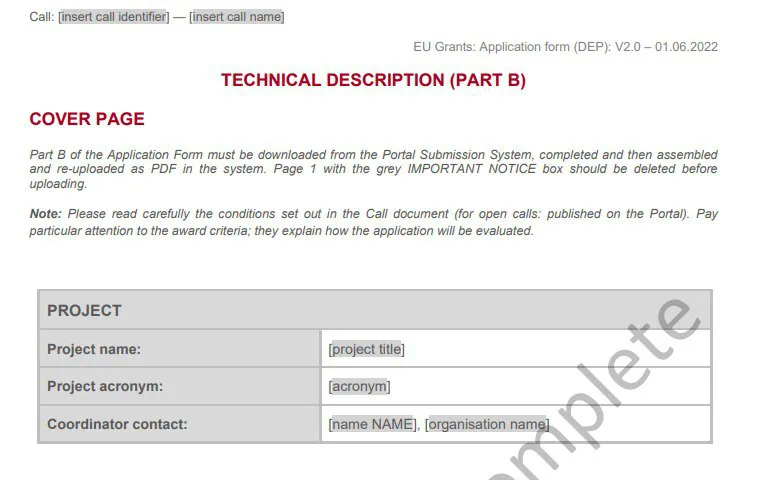
Submission format:
PDF file
Language: English
File name: PartB_<Acronym>.pdf
Length: up to 45 pages (unless otherwise stated in the call conditions)
5.1 Excellence (Alignment with Programme Objectives)
Project Objectives
This section is the foundation of your application. You must clearly and concisely describe the concrete results you aim to achieve. Ideally, define between 2 and 5 SMART objectives (Specific, Measurable, Achievable, Relevant, Time-bound):
Specific: Objectives should be clearly defined without ambiguity.
E.g., “Improve digital skills of 500 SME employees” instead of “Improve digital skills”.
Measurable: You should be able to demonstrate whether the goal has been achieved (number of users, % increase in productivity, etc.).
Achievable: The objective must be realistic considering your team’s resources, time, and competencies.
Relevant: Objectives should align with the Programme’s priorities — e.g., infrastructure development, cybersecurity, artificial intelligence, digital skills.
Time-bound: Set clear timeframes for completion.
Practical tips:
Include specific Key Performance Indicators (KPIs) — this helps evaluators grasp the scale and ambition.
Explain how each objective aligns with EU priorities.
Use simple, clear language.
Examples:
“The objective is to create a cloud platform to improve access to digital public services in rural regions.”
“We will use an agile model with short iterations and regular user feedback.”
Example objective formulation:
“To develop and implement an integrated digital platform for urban infrastructure management that improves resource efficiency by 20% within 24 months.”
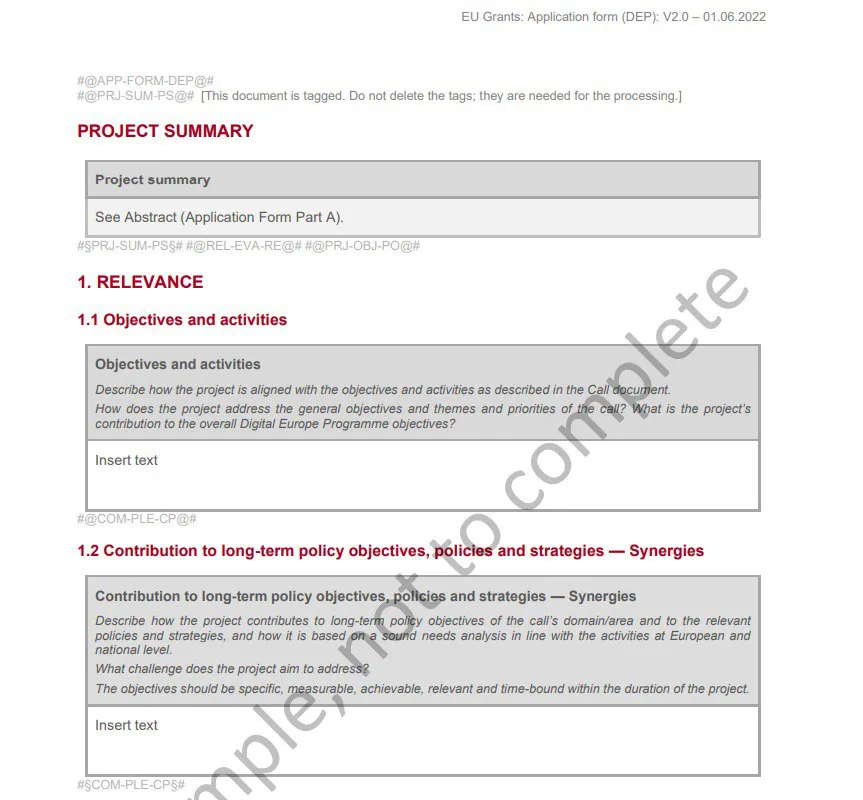
5.2 Overall Approach and Methodology
In this section, describe in detail how you plan to achieve your stated objectives:
What technologies, approaches, and methods you will use (e.g., agile development, co-creation, IoT, cloud services).
The logical flow of work: development stages, iterations, testing, and deployment.
How end users will be involved in the process (co-creation, surveys, piloting).
Why do you choose these specific methods over others? Justify the advantages and relevance.
Practical tips:
Use diagrams or flowcharts to visually explain processes.
Justify your choice of technologies and methods with reference to current trends and best practices.
Explain how your approach supports effective implementation and risk mitigation.
5.3 Innovation and EU Policy Alignment
This section is essential for demonstrating the uniqueness of your project:
Describe what makes your initiative different from existing ones.
Provide examples of new technologies, organisational models, or social approaches.
Show alignment with major EU digital strategies (e.g., Digital Decade 2030, AI Act, EU Data Strategy, Green Deal).
Address ethical, security, and privacy considerations.
Practical tips:
Briefly review the relevant EU policy documents and explain how your project relates to them.
Avoid overly technical jargon, focus on value and innovation.
If your consortium includes unique organisations or uses cutting-edge technologies, highlight this clearly.
5.4 Synergies with Other Initiatives
The EU values projects that are not isolated but build on or connect with other programmes:
Describe how your project will collaborate with other EU initiatives (e.g., Horizon Europe, CEF Digital, national programmes).
Explain how your project will reuse or build upon outcomes of previous initiatives.
Demonstrate your awareness of the wider EU digital landscape.
5.5 Impact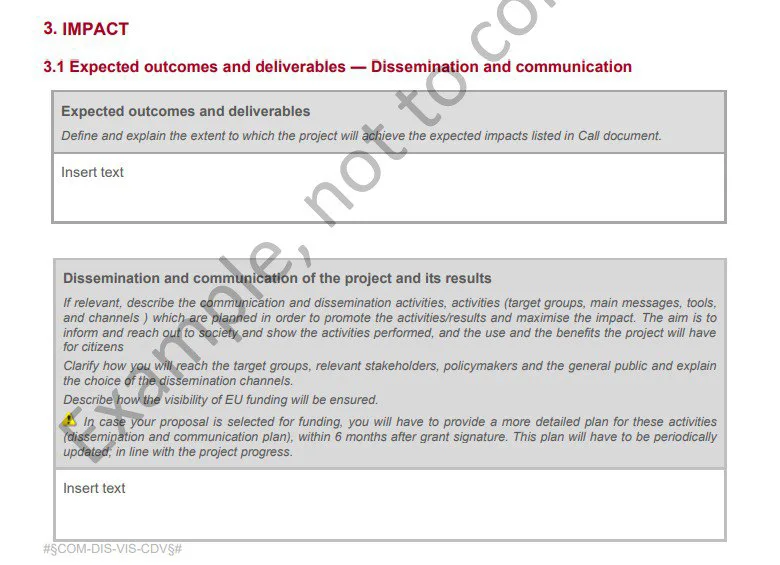
Impact on the EU, Member States, Market, and Society
Describe who will benefit from the project:
Potential groups: citizens, businesses (especially SMEs), public authorities, research and education institutions.
Positive changes: economic growth, increased competitiveness, digital inclusion, and environmental sustainability.
Practical tips:
Provide both quantitative (e.g., 1,000 users, 15% increase in productivity) and qualitative indicators (e.g., improved access, increased trust).
Explain how your project contributes to EU digital sovereignty.
Dissemination, Exploitation, and Scalability Strategy
Explain how your project’s results will be shared and used after the funding period:
Through websites, conferences, publications, APIs, and open-source platforms.
Plans for commercialisation or integration into existing systems.
Potential for scaling to other countries, industries, or sectors.
Contribution to EU Digital Capacity
Describe how your project will reduce the EU’s dependence on non-EU technologies:
Use of open-source software.
Development of local or European solutions.
Implementation of European security and interoperability standards.
5.6 Implementation
This is one of the most critical parts of the application. Here, the consortium must prove its ability to implement the proposed project effectively, with a clear structure, responsible partners, a realistic timeline, a strong governance system, risk control, and clearly defined outputs. The European Commission evaluates not only the quality of ideas but also the capacity to deliver, without delays, chaos, or loss of focus.
Work Packages (WPs)
Projects are broken down into logical blocks called Work Packages (WPs) — this is standard in EU-funded projects. For example:
WP1 — Project management
WP2 — Software development
WP3 — User piloting
WP4 — Communication and dissemination
For each WP, the application should clearly define:
Title — short but meaningful
Objective — what you plan to achieve in the WP
Tasks — specific actions within the WP
Expected results — deliverables or outcomes
Duration — timeline in months
Responsible partners — who is in charge
Tip: Don’t overload WPs, 5–7 well-structured packages are better than 12 scattered ones.
Implementation Timeline (Gantt Chart / Roadmap)
The Commission expects a visual project timeline, usually as a Gantt chart. It should show:
Start and end dates for each WP
Overlaps between tasks
Key milestones
Timing of major deliverables
This helps evaluators assess whether:
The schedule is realistic
Activities are logically ordered
Tasks aren’t duplicated
Tip: Include a time buffer; having some flexibility at the end of the project is beneficial.
Partner Roles and Expertise
This section should demonstrate the strength and balance of your team. Describe:
Who is responsible for what — distribution of WPs among partners
Why these partners were selected — experience, geographic reach, technical and organisational strengths
How collaboration works — not just formal roles, but daily cooperation mechanisms
Important: Show that partners are complementary, not competitive.
Project Management Structure
Outline how the project will be governed. Typical roles include:
Coordinator — main contact, responsible for reporting, budget, and communication with the Commission
Steering Committee — makes strategic decisions
Technical Board — oversees the content and direction of the project
Management tools — e.g., platforms for collaboration, monitoring, documentation
Communication and reporting — how and when partners meet, documentation protocols
Tip: Avoid unnecessary bureaucracy — your governance structure should be lean and effective.
Step 6. Annexes — Attachments to the Proposal
Annexes are an essential part of the full project proposal. They confirm the organisational, technical, human, and ethical capacity of the consortium. Some are mandatory for specific call types, while others are recommended to strengthen the application.
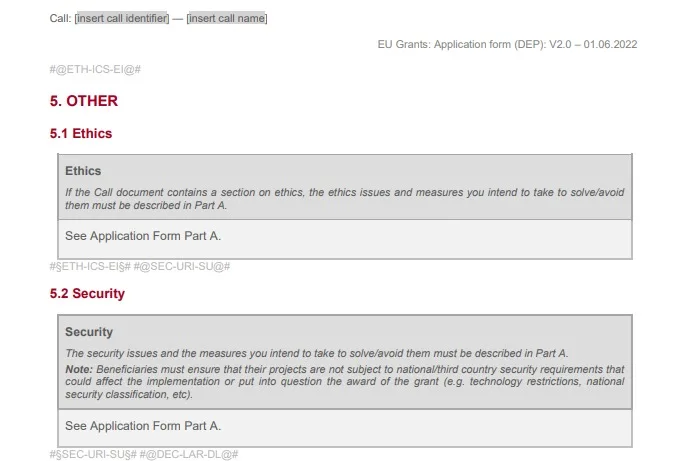
6.1. Letters of Support / Commitment
What it is:
Official letters from third parties (e.g. public authorities, businesses, industry associations, cities or regions) confirming their interest in the project or willingness to cooperate/use its results.
Purpose:
To demonstrate the practical value of the project.
To highlight potential for scalability or implementation.
To build credibility for the consortium.
What it should include:
Project title and brief description.
Confirmation of support.
Specific interest or role of the third party.
Signature of an authorised representative.
Organisation letterhead.
Format: PDF, in English (or with a certified translation).
6.2. Data Management Plan (DMP)
What it is:
A description of the policy, approaches, and mechanisms for handling data that will be generated or used in the project.
Purpose:
To ensure compliance with the FAIR principles (Findable, Accessible, Interoperable, Reusable).
To explain how data security, preservation, and openness will be addressed.
Should include:
Types of data to be generated.
Methods for storing and securing data.
Access limitations (if sensitive information is involved).
Long-term data preservation plan.
Platforms for open access (if applicable).
Format: Word or PDF. Often submitted separately during or after project start but may be required at the proposal stage.
6.3. CVs of Key Experts
What it is:
Concise professional CVs of key project members (WP leaders, technical leads, ethics experts, project managers).
Purpose:
To demonstrate the expertise within the team.
To show that the staff fit their roles in the project.
To build trust in the team’s capacity to implement the project.
Recommended contents:
Full name, current position, organisation.
Education and key qualifications.
Relevant project experience (especially Horizon Europe, CEF, etc.).
Key publications or projects (up to 5 main items).
Participation in professional networks.
Format: No fixed template but following the Europass structure or similar is recommended. Max. 2 pages per expert.
6.4. Ethics Self-Assessment
What it is:
A self-evaluation form ensuring that the project aligns with EU ethical standards (especially where personal data, biometrics, surveillance, AI, etc. are involved).
Purpose:
To identify potential ethical risks.
To assess the need for further ethics review.
To show responsibility in the use of digital technologies.
Covers issues such as:
Processing of personal data.
Involvement of vulnerable groups.
Deployment of AI technologies.
Potential impact on human rights.
Future use of technologies.
Format: Submitted as a separate section or annexe to Part B (or via a dedicated form). May be accompanied by a short description of procedures, policies, and tools that ensure ethical compliance.
6.5. Security Issues Table (if applicable)
What it is:
A dedicated section for projects that may pose risks to national or public security (e.g. cybersecurity, critical infrastructure, biometrics, cryptography).
Purpose:
To identify whether a security scrutiny is needed.
To demonstrate control over critical data or components.
Includes:
Answers to predefined questions on sensitive technologies.
Description of access to restricted data or systems.
Security measures are in place.
Format: A table with formal answers to specific questions (submitted via the system or as a separate PDF annexe).
General Recommendations for Annexes
All documents must be in English or accompanied by a translation.
Each file should have a clear name, for example:
Annex1_LetterOfSupport_CityCouncil.pdf
Annex2_DataManagementPlan.pdf
Avoid overloading your application with unnecessary files — only include annexes that strengthen your arguments.
If a separate annexe is not required but the topic is important (e.g. Data Management), address it clearly in the relevant sections of Part B.
Follow specific requirements for your chosen call. Some may request additional or special documents.
Step 7. Submit the application
The coordinator is responsible for submitting both Part A (via online forms) and Part B (as a PDF file) through the Funding & Tenders Opportunities Portal (FToP).
Ensure consistency between Parts A and B (e.g. budget, partner roles).
It is recommended to submit the application 2–3 days before the deadline to avoid technical issues.
Monitor the portal for submission confirmation and evaluation results.
Tip: Save PDF copies of all documents before submitting.
After Submission
Proposals are evaluated based on the following criteria: Excellence, Impact, and Quality of Implementation (details in the call document). Results are typically announced within 3–6 months. More on the evaluation process can be found via the link.
If your application is rejected, carefully review the evaluators’ comments (available through FToP) to improve future applications.
If selected, the consortium will sign a Grant Agreement with the European Commission outlining funding details and obligations.
Accessing the Templates
Templates for Parts A and B are available on the FToP for each specific call. Here’s how to find them:
Funding & Tenders Opportunities Portal (FToP):
Go to: ec.europa.eu/info/funding-tenders/opportunities/portal
In the “Search Funding & Tenders” section, enter Digital Europe Programme or the specific call title.
Select an open or closed call and go to the Call Documents tab.
Download:
Application Form Part A (administrative form, to be completed online).
Application Form Part B (technical description template, to be uploaded as a PDF).
Guide for Applicants.
Example: For the call “DIGITAL-2024-CLOUD-AI-06”, templates are found under the “Application Forms” section (check the specific call).
2. Example of templates search:
For a 2024 call in cybersecurity (e.g. Digital Skills Academy in GenAI), templates can be accessed via the link.
On the call description page, go to the Topic conditions and documents section and review the document templates.
3. Additional template resources:
General templates and examples of documents are available via the link.
Additional Tips
Allocate at least 2–3 months for preparation, including coordination with partners.
Make sure Part B addresses the call’s evaluation criteria.
Have an expert review the English in Part B.
Based on our experience, we have identified key mistakes that can weaken applications submitted to the Digital Europe Programme:
Failing to clearly demonstrate transnational added value.
Lack of complementarity or missing key actors in the value chain.
Missing or vague KPIs (Key Performance Indicators) for success measurement.
Weak sustainability strategy beyond the funding period.
Insufficient alignment with national and EU digital strategies.
Unbalanced or poorly justified resource allocation.
Key Factors for Successful Funding:
Strategic alignment perfectly matches the specific objectives of the Programme and the call.
Concrete and measurable impact, demonstrated through clear and realistic indicators.
A well-balanced consortium involving users, developers, and intermediaries.
Project interoperability and openness aligned with European standards and principles.
Robust sustainability plan for the post-funding period.
Synergies with other initiatives at the EU, national, and regional levels.
Participating in the Digital Europe Programme is not only a way to secure funding. It is also an opportunity to become part of the broader European digital ecosystem, enhance your organisation’s innovation potential, and enter new markets. A
thoroughly prepared application is the key to success in the call.
Remember: Attention to detail, strategic thinking, and clear argumentation are your strongest tools on the path to success. Don’t hesitate to seek partners, consult National Contact Points, and involve experts in refining your application.
European digital opportunities are open to Ukrainian businesses. And the best time to take advantage of them is now.
Reference information:
The European Union’s Digital Europe Programme (2021–2027), with a total budget of €7.5 billion, offers Ukrainian companies access to grant funding for digital technology projects. Since Ukraine joined the programme in September 2022, Ukrainian organisations can participate in calls focused on AI, cybersecurity, high-performance computing, semiconductors, digital skills, and technology adoption. Between 2025–2027, €3.2 billion is earmarked for these goals, opening significant opportunities for Ukrainian businesses.
In September 2023, the State Institution “Entrepreneurship and Export Promotion Office” was designated as Ukraine’s National Contact Point (NCP) for the Digital Europe Programme. The Office informs stakeholders about EU digital policy and available opportunities within the Programme.
Disclaimer: This guide was developed within the activities of the National Contact Point of the “Digital Europe” Programme in Ukraine, coordinated by the Entrepreneurship and Export Promotion Office with the support of the GIZ project “Digital Transformation of SMEs in the Eastern Partnership Countries.”